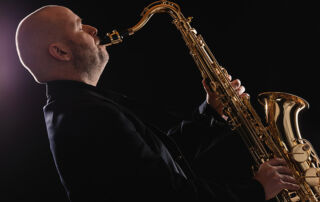One of the most common questions I hear from my students is: How should I breathe when singing?
And you? Do you know how to breathe when singing?
I’m sure each of you has a different explanation of this concept.
I’ve taken numerous voice training courses, and breathing seems to be the topic where every vocal professional has their own take.
Singers often panic, thinking they don’t know how to breathe properly.
In classical vocal technique, breathing plays such a central role that we often forget many other factors contribute to sound production, such as vocal cord closure, larynx positioning, relaxation, muscular energy, and much more.
You’ve probably heard that you should sing with your diaphragm, breathe with your belly, support your voice, press, and so on.
The world of singing seems obsessed with the "right" way to breathe, as if breathing alone is what makes us great singers.
Let’s think about it: Trumpet players have great breath control. Does that mean all trumpet players are amazing singers?
It’s time to demystify breathing and talk a bit about the science behind it.

The science of breathing
You breathe every day, and quite well, I assume—otherwise, you wouldn’t be able to read this article.
Your body already knows the basics: the lungs expand to let air in and contract to push air out. And if you want to see exactly how it works, click here.
The diaphragm you see in the image is an inspiratory muscle, whereas phonation (speaking or singing) happens on the breath, meaning during exhalation.
Once you realise this, you’ll understand that “singing with the diaphragm” doesn’t actually mean anything. The diaphragm contracts during inhalation and relaxes during exhalation.
You can’t feel it or control it—you simply have to let it do its job.

Mastering exhalation for singing
What about belly breathing?
If anyone has ever felt their lungs in their belly, call me—or better yet, call emergency services—because I think there’s a problem!
In reality, teachers who tell you to “breathe with your belly” are making a huge simplification that can lead you in the wrong direction, such as trying to push or inflate your belly.
Here’s what actually happens: when you inhale, your belly—or more precisely, your abdominal muscles—relax.
At the same time, the ribs expand, and so does the back. You can feel inhalation as a 360-degree expansion of the body.
This will help you avoid tension and stiffness.
Logically, natural exhalation is simply the same process in reverse. In everyday life, exhalation happens very quickly.
However, when we sing or even speak, we need more time to articulate or sustain phrases without taking a breath every two seconds.
Normal exhalation isn’t enough in these cases, so we need to adjust something.
Our job as vocalists is to slow down exhalation and delay the moment of release.
To do this, we resist the lowering of the ribs and keep them expanded for as long as possible.
When that’s no longer enough, we engage the abdominal muscles to increase resistance and extend the duration of exhalation.

Practical breathing exercises
Now, let’s move on to practice. If you're here, it's because you're looking for tips to improve your breathing for singing. There’s no magic formula that works for everyone, as every body is different. But I still suggest you try the following exercise:
- Take an object, such as an empty cup or a book.
- Lie down on the floor, on your back.
- Place the object on your belly, around the navel.
- Continue to breathe in and out normally.
You’ll notice that the object rises as you inhale and falls as you exhale.
Do this several times, then try to slow down the descent of the book or cup. By slowing down your exhalation, you’ll feel the resistance mentioned earlier.
Next, remove the object, stand up, and do the same thing again.
Another exercise that may be helpful if you want to increase your breathing capacity is this one:
- Inhale while relaxing the area around your navel for 5 seconds (like when you’re comfortably settled in front of your favourite show or after a meal), without trying to "inflate" or "push" your belly.
- Hold your breath for 5 seconds.
- Exhale on an "S ss" sound for 5 seconds, gradually drawing your navel towards your back. Try to maintain an even volume. Your abdomen will gradually contract, without any sudden tightening.
- Then, do the same thing while increasing the duration.
Once you feel comfortable with this exercise, take a relatively long phrase from your song and practise with it.
The goal is to feel free without the sensation of exerting too much effort.
After doing these exercises, sing your song without thinking about your breathing.
You can record yourself to analyse whether your singing feels freer.
But don’t make the mistake of overthinking your breathing while you’re singing a song.
With practise, your body will get used to relaxing and engaging when necessary.
All these tips work for independent practice but will be even more effective with the presence and expertise of a singing teacher.

Conclusion – Breathing is just one element of vocal technique
If you take away one thing from this article: breathing isn’t everything; it’s one element of technique, and good breathing technique doesn’t guarantee good vocal technique.
Don’t forget to work on all elements of vocal technique to achieve a healthy and balanced vocal function.
If you would like guidance in working on your voice, feel free to get in touch with Paris Music Institute.








